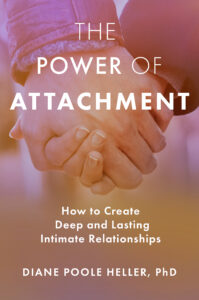THE POWER OF ATTACHMENT:
HOW TO CREATE DEEP AND LASTING INTIMATE RELATIONSHIPS
 Written by Diane Poole Heller, PhD
Written by Diane Poole Heller, PhD
Reviewed by Nancy Eichhorn, PhD
Do you long for connection? To feel that special moment of meeting when someone feels into you, when they resonate and attune to you?
Do you wonder what it might feel like? Have you felt it once, long ago, but feel as if it’s gone, a distant memory?
Is someone in your life already offering you that sense of connection but you’re not able to let it in?
Perhaps you push it away? Avoid it at all costs? Maybe it’s too scary? Maybe it’s too uncertain, that sense of, why get close when they’re just going to abandon me, anyway? Maybe your disconnection from yourself, done during a war-zone- type-childhood to survive the fracas, is limiting your ability to be close, to feel the closeness that you crave.
The fear that comes during a childhood marked by rejection, neglect, withholding of love, threats and abuse leaves its mark. As adults we’re left longing to be felt, seen, held, witnessed in our entirety with love and compassion and to return those same feelings to another human being. Most people yearn to be in a close, lasting, loving relationship.
But, is it possible to change at this point in our lives? We’re not children anymore. We’re adults living adult lives, trying to maintain adult relationships all the while feeling empty, alone, lost, isolated, disconnected.
Can it be different?
According to Diane Poole Heller, a pioneer in attachment theory and a leading expert in Adult Attachment Theory, we can learn how to have meaningful lasting relationships despite complicated formative years that may have impacted our attachment style and our willingness to risk close ties, including those that are intimate and/or platonic.
She is clear that “beneath scars and maladapted behaviors, we all have an attachment system that’s oriented to trust and togetherness with loved ones” (pg. 9).
How does she know?
Heller was in an accident days before her wedding (in 1988). She was driving (at 55 mph) and noticed the bride-and-groom wedding-topper her soon-to- be mother-in-law had given her slipping toward the passenger floorboard. Not wanting the precious gift to fall and break, she clipped off her seat belt and leaned over to grab the figurine. In so doing, she pulled on the steering wheel, her car swerved and smashed head-on into another car.
While the driver in the other car walked away “relatively unscathed”, Heller suffered a traumatic brain injury. The wedding went on, but the impact of the accident created long lasting shock waves of disconnection, pain, dissociation, memory loss, and memory flashbacks from a traumatic childhood that had long been buried. She sought help. Thus, her life’s work began.
Healing: Self and Others
Meeting Peter Levine and working with him via Somatic Experiencing brought release, change, aliveness and wellbeing. Heller continued as an SE student and with time she became an SE facilitator. She has taught SE worldwide
for more than twenty-five years. These experiences supported her personal and professional goal to help herself and others to “reconnect in relationship in the face of isolation and dissociation that can accompany traumatic experiences” (pg. 3).
Questions have guided Heller’s explorations and in turn the answers form the body of her work and this book. The major topics that keep bubbling to the surface include:
“How do we heal broken connections to our self and others, and how can we come back to a sense of wholeness?
How do we integrate our diverse experiences and all the parts of our self that feel so broken and fragmented?
How do we emerge from incredible loss, fear, and powerlessness
to regain empowerment and resiliency?
When trauma robs us of our physical self through dissociation or loss of boundaries, how do we become embodied and safely connected again?
How do we reclaim our birthright to feel grounded and centered, to feel connection and compassion, to have access to all the facets of our humanness and our spiritual nature?” (pp 3-4).
The answers, according to Heller, come by way of attachment theory. As we decipher our early attachment history and explore our different attachment styles to determine our dominant patterns, we can heal our attachment wounds.
The Book
Heller provides a clear discussion to help readers understand attachment theory in general and the different attachment styles, noted as secure, anxious, ambivalent, and disorganized. At the end of each chapter there are questions to help readers assess which style they may align more with. I appreciated the direction to answer the questions, twice. First, when you are imagining a relaxed situation and second when you are tense, feeling defensive, upset. The results are indeed different. I also thought it wise to let readers know that our attachment style is not fixed in one category or the other. Our attachment style is individualized, and fluid, flexible. In some relationships we may have a sense of a secure attachment while in another we might feel more avoidant or ambivert. The key is to consider your patterns, the consistency of the connections you experience, and with which sorts of people.
Exercises throughout each chapter involve reflection, meditation, writing, directed visualizations. They are designed to help readers identify the root causes of their issues as well as potential difficulties and strengths within their relationships. Heller sets the groundwork so readers can grow stronger and move forward from what’s holding them back in isolation and loneliness.
Peter Levine offers his thoughts in the Foreward, talking at length about hero’s and healing. He notes that Heller’s exercises “will certainly help you rediscover your true, embodied self, and will guide you to renegotiate your own obstacles to connections with others” (pg. xii).
Heller then spends time in her introduction setting the stage for the exercises she shares and grounding attachment theory and its place in our adult lives today. The following four chapters are devoted to the attachment styles: secure attachment, avoidant attachment, ambivalent attachment, and disorganized attachment, and then she discusses attachment styles and romantic partnerships. She ends with acknowledgments, notes, a selected bibliography, an index and the ‘about the author’ information.
I appreciated her introduction of the term ‘contingency’. It’s an important concept within attachment theory and it’s the word that captures the feeling that many people crave: a relational experience where you feel understood by another person; you feel this person is attuned to you, resonates with who you are (pg.10).
Cognitive Development, Brain Science and Attachment Theory
To help readers understand how disruptions/disturbances in our early  attachment experiences result in attachment adaptations, Heller shows how the brain shapes itself around our relational environment. She clarifies the concept of neuronal pruning noting that our “brain is born fat . . .” meaning it comes with lots of extra cells, aka extra potential, in case we need them. This way, if things are positive and safe and people are responsive as you grow up, “the parts of the brain aligned with secure attachment are highly structured, evolved and easy to access” (pg.17). Whereas, a child’s brain growing up in a less- than-ideal home will prune away the parts aligned with secure attachment and emphasize its own defensive mechanisms (i.e. flight, fight, hypervigilance, etc.). Because our brain is built for growth and adaptation (neuroplasticity), as adults we can “affect our neural pathways and steer them in the direction of secure attachments” (pg.18).
attachment experiences result in attachment adaptations, Heller shows how the brain shapes itself around our relational environment. She clarifies the concept of neuronal pruning noting that our “brain is born fat . . .” meaning it comes with lots of extra cells, aka extra potential, in case we need them. This way, if things are positive and safe and people are responsive as you grow up, “the parts of the brain aligned with secure attachment are highly structured, evolved and easy to access” (pg.17). Whereas, a child’s brain growing up in a less- than-ideal home will prune away the parts aligned with secure attachment and emphasize its own defensive mechanisms (i.e. flight, fight, hypervigilance, etc.). Because our brain is built for growth and adaptation (neuroplasticity), as adults we can “affect our neural pathways and steer them in the direction of secure attachments” (pg.18).
 Attachment Styles
Attachment Styles
As mentioned previously, each chapter covers one attachment style. The writing is easy to stay with. Heller paces information with stories, examples, and exercises. She explains that while doing the exercises, old wounds may surface, you may feel as if something is happening now in the present moment (when you connect with a sensation stored in the amygdala, memories surface without a story but fresh as if in the moment). She offers ways to mitigate this situation, to titrate what is happening, or to stop the process all together.
She offered that one way to read the book was to simply practice the Secure Attachment Skills offered in Chapter 1. She starts the chapter explaining what secure attachment is not and then delves into what it is . . . in short, secure attachment is attunement. Heller writes that it “reflects a positive-enough environment that creates and engenders basic trust”. It comes when children grow-up feeling taken care of, protected, when they have compassionate parents who are on their side, who understand them, who get them. These parents offer their children autonomy as well as interdependence and they’re safe enough in themselves so everyone can let their guard down, play, be close, touch (appropriately), and have fun together (citing social engagement and Stephen Porge’s Polyvagal theory). Resiliency was also mentioned.
There are 12 Secure Attachment Skills (SAS) offered in Chapter 1 with  definitions, descriptions and exercises to do solo and in relationship. They include: Listen deeply, practice presence, attune, engage in joint attention, maintain contact, be mindful of comings and goings, use your eyes, play, un-automate, repair, build and expand your resources, and attend to the good.
definitions, descriptions and exercises to do solo and in relationship. They include: Listen deeply, practice presence, attune, engage in joint attention, maintain contact, be mindful of comings and goings, use your eyes, play, un-automate, repair, build and expand your resources, and attend to the good.
I offer a caveat. While some readers scanning this review might think they know how to do all Secure Attachment Skills, I counter that they’re not what you think. Heller’s descriptions and exercises are clear, concise, and at times challenging. The meanings of each word in the Secure Attachment Skills list might sound familiar but when you do them in relationship with yourself and others the words change from nouns to verbs. You are engaged and connected and sensing and feeling, and at times it might be vastly different than your preconceived definition of the noun experience.
Coming to a Close
There’s much to read and do and experience and learn in this book. I’ve barely started the Secure Attachment Skills. I want space for practice and exploration. Sections need rereading, especially the chapter on romantic partnerships. This is one of those books that having read it once through, I can now pick it up, open to any page at random, and find something intriguing, informative, energizing.






